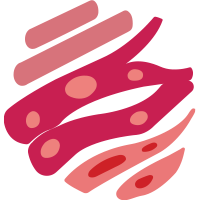
Muscle Cell News
Muscle Cell News is an online resource dedicated to the latest research into smooth, skeletal, and cardiac muscle cells.
STING Aggravates Ferroptosis-Dependent Myocardial Ischemia-Reperfusion Injury by Targeting GPX4 for Autophagic Degradation
[Signal Transduction and Targeted Therapy] The authors discovered that during myocardial ischemia-reperfusion, double-stranded DNA-cyclic GMP-AMP synthase-stimulator of interferon genes (STING) signal accumulated, accompanied by high rates of myocardial ferroptosis.
BMAL1-HIF2A Heterodimer Modulates Circadian Variations of Myocardial Injury
[Nature] Investigators showed that the core circadian transcription factor BMAL1 regulated circadian-dependent myocardial injury by forming a transcriptionally active heterodimer with a non-canonical partner, hypoxia-inducible factor 2 alpha (HIF2A), in a diurnal manner.
Inhibition of Ceramide Synthesis Improves the Outcome of Ischemia/Reperfusion Injury in Cardiomyocytes Derived from Human Induced Pluripotent Stem Cell
[Stem Cell Research & Therapy] Serum- and glucose-free media was used to expose hiPSC-derived cardiomyocytes to hypoxia for 6 hours, followed by reoxygenation for 16 hours.
Bioinstructive Scaffolds Enhance Stem Cell Engraftment for Functional Tissue Regeneration
[Nature Materials] Scientists introduced a bioconstruct engineered for the staged release of growth factors, tailored to direct different phases of muscle regeneration.
NOR-1 Overexpression Elevates Myoglobin Expression via PERM1 and Enhances Mitochondrial Function and Endurance in Skeletal Muscles of Aged Mice
[FASEB Journal] Transcriptomic profiling of the human response to exercise revealed that the nuclear receptor NR4A3 (NOR-1) was among the most responsive genes to acute exercise.
One-Step Laser-Assisted Electrohydrodynamic Printing of Microelectronic Scaffolds for Electrophysiological Monitoring of Aligned Cardiomyocytes
[ACS Nano ] A laser-assisted electrohydrodynamic printing strategy was proposed to directly fabricate a microfibrous architecture with built-in microelectronics for electrophysiological monitoring of aligned cardiomyocytes.
Sarcopenia and Skeletal Muscle Loss after CAR T-cell Therapy in Diffuse Large B cell Lymphoma
[Clinical Cancer Research] In 83 large B-cell lymphoma patients, the skeletal muscle index was measured from clinical images obtained at baseline and days 30 and 90 post-therapy.
ATM Knock out Alters Calcium Signaling and Augments Contraction in Skeletal Muscle Cells Differentiated from Human Urine-Derived Stem Cells
[Cell Death Discovery] By using CRISPR/Cas9 technology, the authors knocked out the ataxia telangiectasia mutated (ATM) protein in urine-derived stem cells from healthy donors.
Novel Directly Reprogrammed Smooth Muscle Cells Promote Vascular Regeneration as Microvascular Mural Cells
[Circulation] Scientists applied myocardin and all-trans retinoic acid with specific culture conditions to directly reprogram human dermal fibroblasts into contractile smooth muscle cells.
Mg2+ Influx Mediated by TRPM7 Triggers the Initiation of Muscle Stem Cell Activation
[Science Advances] Scientists identified transient receptor potential melastatin 7 (TRPM7), an Mg2+-permeable ion channel, as a critical regulator of muscle stem cell activation.
Mg2+ Influx Mediated by TRPM7 Triggers the Initiation of Muscle Stem Cell Activation
[Science Advances] Scientists identified transient receptor potential melastatin 7 (TRPM7), an Mg2+-permeable ion channel, as a critical regulator of muscle stem cell activation.
Every day, our editorial team sifts through the most recent scientific literature to help keep researchers and medical professionals current. Muscle Cell News covers the three types of muscle cells: cardiac, skeletal, and smooth muscle. We cover a broad range of topics, including cell culturing, muscle regeneration, and musculoskeletal disorders.

 Cancer Stem Cell News
Cancer Stem Cell News Cell Therapy News
Cell Therapy News Dermal Cell News
Dermal Cell News Endothelial Cell News
Endothelial Cell News ESC & iPSC News
ESC & iPSC News Extracellular Matrix News
Extracellular Matrix News Hematopoiesis News
Hematopoiesis News Hepatic Cell News
Hepatic Cell News Human Immunology News
Human Immunology News Immune Regulation News
Immune Regulation News
 Intestinal Cell News
Intestinal Cell News Mammary Cell News
Mammary Cell News Mesenchymal Cell News
Mesenchymal Cell News Muscle Cell News
Muscle Cell News Neural Cell News
Neural Cell News Organoid News
Organoid News Pancreatic Cell News
Pancreatic Cell News Prostate Cell News
Prostate Cell News Pulmonary Cell News
Pulmonary Cell News
